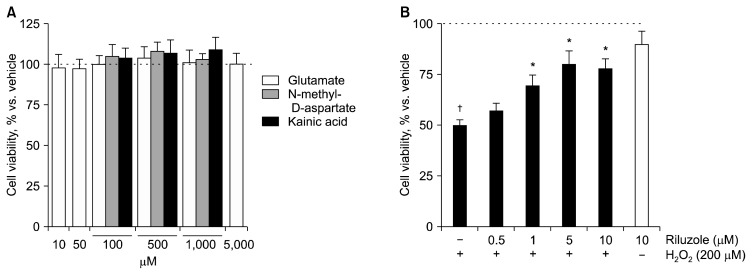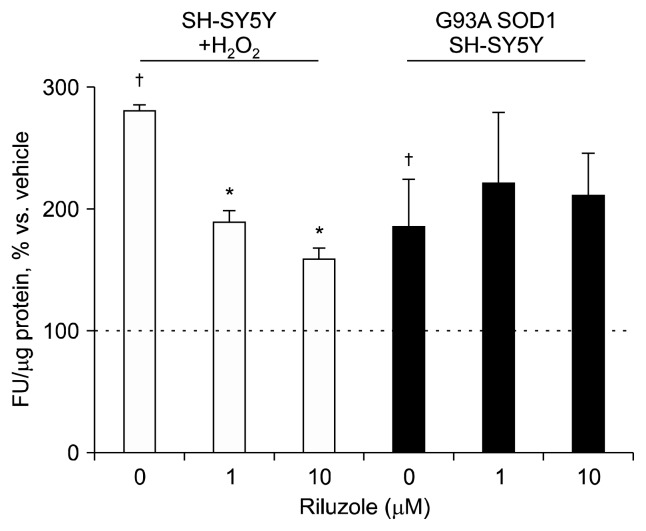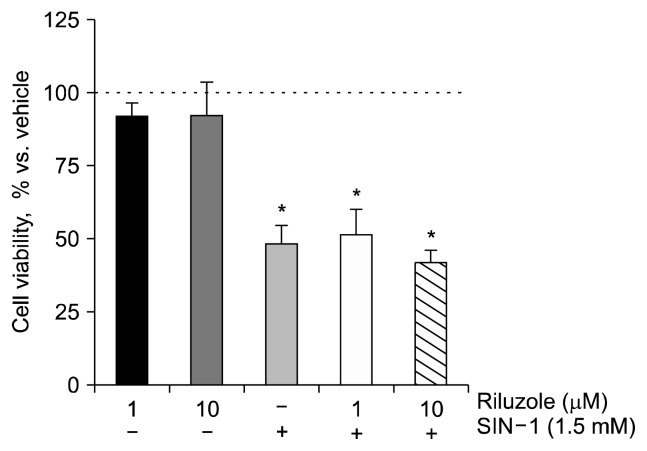Abstract
Objective
Until recently, riluzole was the only drug licensed for amyotrophic lateral sclerosis (ALS). In spite of its efficacy, the mechanism of action remains elusive, and both blocking of glutamate release and antioxidant properties have been postulated. Here we characterized human SH-SY5Y neuroblastoma cell lines, taking advantage of their insensitivity to excitotoxic insults, in order to selectively assess the presence of a direct antioxidant effect of riluzole.
Methods
SH-SY5Y cells, either parental or overexpressing the G93A SOD1 mutation, were exposed for 24 hours to the selected stimuli.
Results
Riluzole (1–10 μM) was able to counteract the effects of H2O2 exposure (200 μM/24 hr), limiting both cell death and whole-cell reactive oxygen species (ROS) increase. The same experiments were repeated using SH-SY5Y cells carrying the familial ALS-related G93A-SOD1 mutation and constitutively expressing two-fold increased whole-cell ROS levels with respect to wild-type cells: riluzole was ineffective in this paradigm. Analogously, riluzole was ineffective in preventing cell death induced by exposing SH-SY5Y cells to 3-morpholino-sydnonimine (SIN-1, 1.5 mM/24 hr), a reactive nitrogen species (RNS) donor.
Conclusion
Our data support a direct antioxidant action of riluzole. Furthermore, the lack of efficacy of riluzole observed in the SOD1 cell model mirrors the lack of efficacy already demonstrated in cognate mouse models of ALS, plausibly reflecting differences in the underlying pathogenic mechanisms. Finally, riluzole inefficacy against nitrosative stress might support the idea that a combined therapeutic intervention may result more effective in ALS patients, as in the case of co-administration of edaravone, a drug known to reduce RNS.
Keywords: Riluzole, Amyotrophic lateral sclerosis, Antioxidants, Drug
INTRODUCTION
Amyotrophic lateral sclerosis (ALS) is a relentless neurodegenerative disease for which no effective therapies exist. Until very recently, riluzole, [i.e., 6-(trifluoromethoxy) benzothiazol-2-amine] was the only drug licensed for ALS, delaying the time points for non invasive ventilation dependence or tracheostomy along the course of this disorder. Riluzole 100 mg/day (usually 50 mg, twice a day) prolongs median survival by few months in patients with ALS according to the conclusions of a recent Cochrane meta-analysis.1) Uncertainties regarding the exact mechanism of action of this drug further complicate the matter and hinder the attempts of designing more potent drugs for increasing life expectancy in ALS. Riluzole specifically blocks tetrodotoxin-sensitive sodium channels reducing calcium influx and excessive glutamate receptor stimulation within the central nervous system.2) Rather than blocking glutamate release, data show that it may increase glutamate uptake in rat spinal cord synaptosomes.3) Direct antioxidant properties of this molecule have already been hypothesized, and riluzole attenuates oxidative stress induced by exposure to various oxidant agents.4,5) However, the demonstration of a direct antioxidant effect of the drug with respect to an indirect antioxidant action due to the anti-glutamatergic properties still remains an open question. This information might be relevant for the ALS field, and may offer clues for novel therapeutic approaches. In fact, in spite of its limited efficacy, riluzole remains the only drug that is ineffective in the SOD1-ALS animal model and effective in human randomized controlled trials.1) Interestingly, the recently US Food and Drug Administration-approved drug for ALS edaravone is able to reduce cerebrospinal fluid (CSF) 3-nitrotyrosine (3NT) levels in ALS patients,6) again reinforcing the idea that scavenging strategies—in this case against markers of nitrosative stress—might delay the disease course in ALS patients.7)
In this work, we used human SH-SY5Y neuroblastoma cell lines: possibly, other cell models could hold higher face, or even predictive validity when thinking to test riluzole effects. Nevertheless, we specifically chose this cell model in order to take advantage of its insensitivity to excitotoxic insults. This offered the unique opportunity of—selectively—assessing any direct effect of riluzole against ALS-related acute and chronic oxidative insults. Finally, a known acute nitrosative stress paradigm, i.e., 3-morpholino-sydnonimine (SIN-1) exposure, was tested as well.8)
METHODS
Cell Cultures
Human SH-SY5Y neuroblastoma cells, either parental, or constitutively expressing the G93A SOD1 mutation were cultured, as previously described.9) Initial experiments were performed for testing the sensitivity of parental SH-SY5Y neuroblastoma cells to excitotoxic insults. Cells were exposed for 24 hours to glutamate (concentration range, 10 to 5,000 μM), N-methyl-D-aspartate (concentration range, 100 to 1,000 μM), kainic acid (concentration range, 10 to 1,000 μM). Riluzole (Sigma; concentration range, 1 to 10 μM/24 hours) was incubated simultaneously to hydrogen peroxide (200 μM/24 hours) or SIN-1 (1.5 mM/24 hours).
Rate of 3-(4,5-Dimethylthiazol-2-yl)-2,5-Diphenyltetrazolimium (MTT) Reduction
Cell cultures were exposed to MTT (0.5 mg/ml final concentration) in standard medium for 45 minutes at 37°C in an atmosphere of 5% CO2 in air; after cell solubilisation in DMSO, absorbance was quantified at 570 nm using a microplate reader (FLUOstar Omega; BMG Labtech, Ortenberg, Germany), as previously described.10) Optical densities were expressed as percent of vehicle-treated control cells.
Whole-cell ROS Levels
The dye 2′,7′-dichlorofluorescein diacetate (DCF-DA) was used to quantify levels of whole-cells reactive oxygen species (ROS), as previously reported.11) Briefly, DCF-DA is de-esterified to the ionized free acid (DCFH), which reacts with ROS to form the fluorescent DCF. Cells were washed once in Locke’s buffer, incubated for 45 minutes in 10 μM DCF-DA and subsequently washed twice. Cells were collected and fluorescence was quantified using a Cary Eclipse fluorimeter (Varian, Palo Alto, CA, USA) (excitation 488 nm, emission 525 nm), after resuspension of the cell pellet in Locke’s buffer containing 0.5% triton X-100. The values of DCF fluorescence were calculated as arbitrary fluorescence unit per μg protein content and expressed as percent of vehicle-treated control cells.
Statistical Analysis
All results are expressed as mean ± standard deviation. One-way ANOVA analysis of variance, followed by Tukey’s multiple comparison test, was used to assess the significance of differences between values of treated versus untreated cells.
RESULTS
Human SH-SY5Y neuroblastoma cells were initially exposed to different excitotoxic insults (glutamate or N-methyl-D-aspartate or kainic acid, in various concentrations for 24 hours; Fig. 1A) without showing signs of altered viability at the MTT assay (Fig. 1A). On the other hand, H2O2 exposure (200 μM/24 hr) was able to significantly decrease (~50%) cell viability (Fig. 1B) and riluzole co-incubation was able to prevent the H2O2-induced cell death; this effect was maximal between 1 and 10 μM (~80% with respect to vehicle-treated cells, Fig. 1B). Whole-cell ROS levels were analogously increased of about three-fold following H2O2 exposure, and this effect was significantly, albeit not completely, prevented by riluzole exposure at the concentration of 1 and 10 μM (striped bars in Fig. 2).
Fig. 1.
(A) Excitotoxic insults (glutamate, 10–5,000 μM; N-methyl-D-aspartate, 100–1,000 μM; kainic acid, 100–1,000 μM; exposure time, 24 hr) do not significantly modify cell viability in SH-SY5Y cells. (B) Exposure of SH-SY5Y cells to H2O2 (200 μM/24 hr) induces a ~50% cell death (†p<0.001 vs. vehicle-treated cells) and riluzole co-exposure (0.5–10 μM/24 hr) significantly prevents H2O2-induced cell death (*p < 0.01 vs. H2O2-treated cells); riluzole exposure (10 μM) alone does not modify cell viability in the same cells.
Fig. 2.
Effect of riluzole exposure (1–10 μM/24 hr) on H2O2-induced whole-cell reactive oxygen species (ROS) production in SH-SY5Y cells. H2O2 (200 μM/24 hr) induces a about three-fold increased ROS production in SH-SY5Y cells (striped bars; †p < 0.001 vs. vehicle-treated cells) and riluzole co-exposure (1–10 μM/24 hr) significantly counteracts H2O2-induced ROS production (*p < 0.05 vs. H2O2-treated cells); black bars show that mutant G93A SOD1 cells display under basal conditions a about two-fold increase of ROS levels with respect to parental cells (†p < 0.001) and that riluzole (1–10 μM/24 hr) is unable to modify this condition.
FU, fluorescence units.
Exposure of SH-SY5Y cells to 1.5 mM/24 hr SIN-1 resulted in a 50% ± 10% mortality, and riluzole 1 or 10 μM failed to significantly counteract this result (Fig. 3).
Fig. 3.
Riluzole co-exposure (1 or 10 μM, 24 hr) does not counteract SIN-1-induced cell death in SH-SY5Y cells (*p < 0.05 vs. vehicle-treated cells).
In SH-SY5Y neuroblastoma cell lines carrying the G93A SOD1 mutation, no significant effect of riluzole exposure (from 0.5 to 10 μM) on cell viability was evidenced (cell viability vs. vehicle–treated cells = 97% ± 6% after 10 μM riluzole). Whole-cell ROS levels were constitutively expressing about two-fold higher with respect to wild-type cells (black bars in Fig. 2), as we previously reported.12) No changes were obtained following riluzole co-incubation (1 and 10 μM; black bars in Fig. 2).
DISCUSSION
ALS pathogenesis is complex and not yet completely elucidated.13) Among the several demonstrated players, excitotoxicity (i.e., excitatory amino acid excessive stimulation) and oxidative stress dominated the early literature, showing complex and clear synergistic interactions.14,15) Notably, this line of research led to the development of riluzole, an anti-glutamatergic compound, and until recently the only effective and licensed drug for ALS treatment.2) Antioxidant properties of riluzole have been repeatedly shown4,5) but there is still partial uncertainty about their direct or indirect nature, due to glutamate transmission block. Koh et al.,4) for example, nicely described the antioxidant effects of riluzole in presence of competitive or uncompetitive inhibitors of glutamate receptors. Here we initially characterized, and then took advantage of the insensitivity to excitotoxic insults of human SH-SY5Y neuroblastoma cells, not just blocking but completely removing the excitotoxic paradigm. In this experimental setting, riluzole was able to counteract H2O2- induced cell death and increased ROS production.
The lack of efficacy of riluzole in our nitrosative stress paradigm seems to support the hypothesis that this drug selectively targets those mechanisms leading to increased ROS production. Consequently, our findings might indirectly sustain the idea that riluzole could really express a synergistic therapeutic potential when in add-on with other drugs, such as edaravone, the newly approved compound able to reduce 3NT CSF content in treated patients.6) Previous attempts of selectively targeting nitrosative stress demonstrated that this therapeutic strategy could be, not only successful in ALS mouse models, but also effective in preventing the accumulation of abnormally phosphorylated and fragmented TDP-43 in spinal cord.16) Furthermore, increased NO levels, spontaneously forming peroxynitrite, arise following exposure to LPS of murine microglial G93A-SOD1 cells, strictly linking nitrosative stress to the well-known ALS-involved mechanism of neuroinflammation.17) Also, NO-dependent post-translational modifications, such as cysteine S-nitrosylation and tyrosine nitration, are linked to abnormal mitochondrial metabolism, another well-known player in ALS pathology.18)
In contrast, riluzole was uneffective in the cell model carrying the G93A SOD1 ALS-causing mutation, constitutively expressing about two-fold increased ROS production, as previously shown.12) This is consistent with the view that an acute exposure to this drug is unable to rescue chronic oxidative damage. In any case, according to our results, riluzole has already been reported to have no significant benefit on lifespan and motor performance in SOD1 G93A transgenic mice.19)
In conclusion, we show here that riluzole demonstrates direct antioxidant defence capacities against acute oxidative, but not nitrosative stress. Furthermore, riluzole was uneffective against a chronic ALS-related paradigm, such as the expression of the SOD1 G93A mutation. This selective scavenging behaviour represents an important piece of information when thinking to novel drug design in the ALS field, since multi-drug cocktails are expected to target different players of motor neuron pathology.20)
Acknowledgments
This study was supported by UNIMIB grant # 2017-ATE-0052 (LT).
Footnotes
Conflicts of Interest
No potential conflict of interest relevant to this article was reported.
REFERENCES
- 1.Miller RG, Mitchell JD, Moore DH. Riluzole for amyotrophic lateral sclerosis (ALS)/motor neuron disease (MND) Cochrane Database Syst Rev. 2012;(3):CD001447. doi: 10.1002/14651858.CD001447.pub3. [DOI] [PMC free article] [PubMed] [Google Scholar]
- 2.Wokke J. Riluzole. Lancet. 1996;348:795–799. doi: 10.1016/S0140-6736(96)03181-9. [DOI] [PubMed] [Google Scholar]
- 3.Azbill RD, Mu X, Springer JE. Riluzole increases high-affinity glutamate uptake in rat spinal cord synaptosomes. Brain Res. 2000;871:175–180. doi: 10.1016/S0006-8993(00)02430-6. [DOI] [PubMed] [Google Scholar]
- 4.Koh JY, Kim DK, Hwang JY, Kim YH, Seo JH. Antioxidative and proapoptotic effects of riluzole on cultured cortical neurons. J Neurochem. 1999;72:716–723. doi: 10.1046/j.1471-4159.1999.0720716.x. [DOI] [PubMed] [Google Scholar]
- 5.Storch A, Burkhardt K, Ludolph AC, Schwarz J. Protective effects of riluzole on dopamine neurons: involvement of oxidative stress and cellular energy metabolism. J Neurochem. 2000;75:2259–2269. doi: 10.1046/j.1471-4159.2000.0752259.x. [DOI] [PubMed] [Google Scholar]
- 6.Yoshino H, Kimura A. Investigation of the therapeutic effects of edaravone, a free radical scavenger, on amyotrophic lateral sclerosis (Phase II study) Amyotroph Lateral Scler. 2006;7:241–245. doi: 10.1080/17482960600881870. [DOI] [PubMed] [Google Scholar]
- 7.Nagase M, Yamamoto Y, Miyazaki Y, Yoshino H. Increased oxidative stress in patients with amyotrophic lateral sclerosis and the effect of edaravone administration. Redox Rep. 2016;21:104–112. doi: 10.1179/1351000215Y.0000000026. [DOI] [PMC free article] [PubMed] [Google Scholar]
- 8.Aguirre T, Van Den Bosch L, Goetschalckx K, Tilkin P, Mathijs G, Cassiman JJ, et al. Increased sensitivity of fibroblasts from amyotrophic lateral sclerosis patients to oxidative stress. Ann Neurol. 1998;43:452–457. doi: 10.1002/ana.410430407. [DOI] [PubMed] [Google Scholar]
- 9.Sala G, Beretta S, Ceresa C, Mattavelli L, Zoia C, Tremolizzo L, et al. Impairment of glutamate transport and increased vulnerability to oxidative stress in neuroblastoma SH-SY5Y cells expressing a Cu, Zn superoxide dismutase typical of familial amyotrophic lateral sclerosis. Neurochem Int. 2005;46:227–234. doi: 10.1016/j.neuint.2004.10.002. [DOI] [PubMed] [Google Scholar]
- 10.Sala G, Marinig D, Riva C, Arosio A, Stefanoni G, Brighina L, et al. Rotenone down-regulates HSPA8/hsc70 chaperone protein in vitro: a new possible toxic mechanism contributing to Parkinson’s disease. Neurotoxicology. 2016;54:161–169. doi: 10.1016/j.neuro.2016.04.018. [DOI] [PubMed] [Google Scholar]
- 11.Sala G, Trombin F, Mattavelli L, Beretta S, Tremolizzo L, Andreoni S, et al. Lack of evidence for oxidative stress in sporadic amyotrophic lateral sclerosis fibroblasts. Neurodegener Dis. 2009;6:9–15. doi: 10.1159/000121390. [DOI] [PubMed] [Google Scholar]
- 12.Beretta S, Sala G, Mattavelli L, Ceresa C, Casciati A, Ferri A, et al. Mitochondrial dysfunction due to mutant copper/zinc superoxide dismutase associated with amyotrophic lateral sclerosis is reversed by N-acetylcysteine. Neurobiol Dis. 2003;13:213–221. doi: 10.1016/S0969-9961(03)00043-3. [DOI] [PubMed] [Google Scholar]
- 13.Hardiman O, Al-Chalabi A, Chio A, Corr EM, Logroscino G, Robberecht W, et al. Amyotrophic lateral sclerosis. Nat Rev Dis Primers. 2017;3:17085. doi: 10.1038/nrdp.2017.85. [DOI] [PubMed] [Google Scholar]
- 14.Tremolizzo L, Sala G, Brighina L, Beretta S, Ferrarese C. Interactions between excitotoxicity and oxidative stress in ALS: clues for pharmacotherapy. In: Murray CA, editor. Amyotrophic lateral sclerosis: new research. New York: Nova Science Publishers; 2005. pp. 71–109. [Google Scholar]
- 15.Bondy SC, LeBel CP. The relationship between excitotoxicity and oxidative stress in the central nervous system. Free Radic Biol Med. 1993;14:633–642. doi: 10.1016/0891-5849(93)90144-J. [DOI] [PubMed] [Google Scholar]
- 16.Soon CP, Donnelly PS, Turner BJ, Hung LW, Crouch PJ, Sherratt NA, et al. Diacetylbis(N(4)-methylthiosemicarbazonato) copper(II) (CuII(atsm)) protects against peroxynitrite-induced nitrosative damage and prolongs survival in amyotrophic lateral sclerosis mouse model. J Biol Chem. 2011;286:44035–44044. doi: 10.1074/jbc.M111.274407. [DOI] [PMC free article] [PubMed] [Google Scholar]
- 17.Bellezza I, Grottelli S, Costanzi E, Scarpelli P, Pigna E, Morozzi G, et al. Peroxynitrite activates the NLRP3 inflammasome cascade in SOD1 (G93A) mouse model of amyotrophic lateral sclerosis. Mol Neurobiol. 2018;55:2350–2361. doi: 10.1007/s12035-017-0502-x. [DOI] [PubMed] [Google Scholar]
- 18.Nakamura T, Lipton SA. ‘SNO’-Storms compromise protein activity and mitochondrial metabolism in neurodegenerative disorders. Trends Endocrinol Metab. 2017;28:879–892. doi: 10.1016/j.tem.2017.10.004. [DOI] [PMC free article] [PubMed] [Google Scholar]
- 19.Hogg MC, Halang L, Woods I, Coughlan KS, Prehn JHM. Riluzole does not improve lifespan or motor function in three ALS mouse models. Amyotroph Lateral Scler Frontotemporal Degener. 2018;19:438–445. doi: 10.1080/21678421.2017.1407796. [DOI] [PubMed] [Google Scholar]
- 20.Ahmadi M, Agah E, Nafissi S, Jaafari MR, Harirchian MH, Sarraf P, et al. Safety and efficacy of nanocurcumin as add-on therapy to riluzole in patients with amyotrophic lateral sclerosis: a pilot randomized clinical trial. Neurotherapeutics. 2018;15:430–438. doi: 10.1007/s13311-018-0606-7. [DOI] [PMC free article] [PubMed] [Google Scholar]





